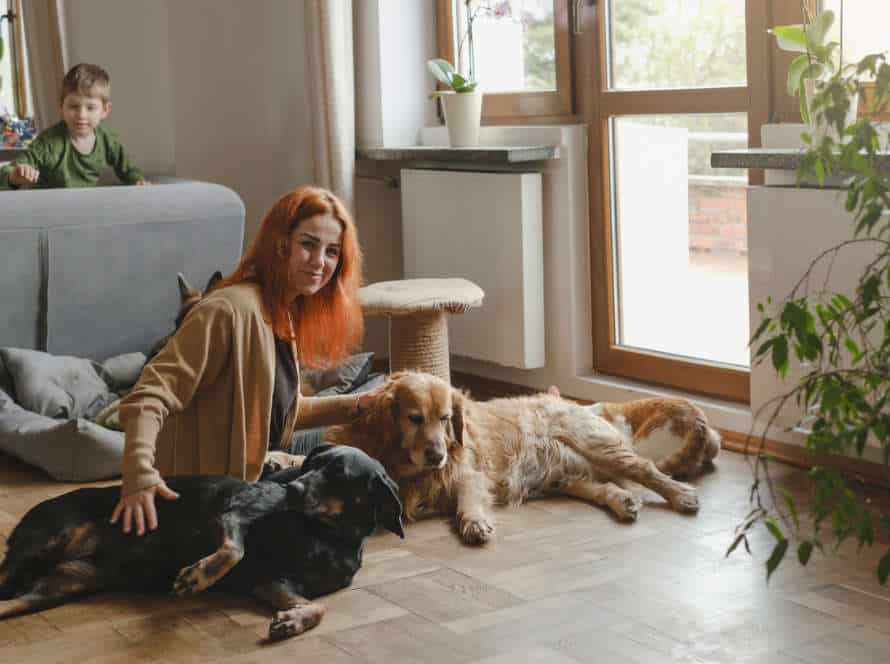Helping Your Dog Cope with Fearful Situations
Dogs can feel anxious and afraid in certain scenarios, like during thunderstorms, fireworks, or vet visits. It is important to help them manage this stress for their well-being. Here are four ways to do so:
- Give your dog a safe space to go to.
- Use behavior modification techniques, such as desensitization and counter-conditioning.
- Talk to a vet about medication that could help.
- Hire a professional dog trainer for a controlled and safe environment.
These techniques can help your pup feel more secure in times of fear and anxiety. Pro Tip: Consistency is key! With patience and a relaxed attitude, you can help your dog develop strategies to manage their stress in the future.
Understanding Dog’s Fearful Behaviors
Recognizing and comprehending your pup’s scared habits is the initial step in aiding them cope with fearful conditions. Grasping the evidence of fear in your dog and the sources of their fear can assist you make a road map to help them be calmer and more positive in contrasting conditions.
Let’s have an in-depth look at how to recognize and get a handle on your dog’s fearful behaviors.
Recognize symptoms of anxiety and fear in dogs
Anxiety and fear in dogs is common. Pet owners should recognize the signs to help their furry friends. Here are some indications:
- Pacing, shaking, or trembling
- Excessive barking or whining
- Panting or heavy breathing
- Dilated pupils and a tense body posture
- Attempts to escape or hide
- Destructive behavior such as chewing or digging
- Loss of appetite
If your pup has any of these signs, identify the source of their fear and address it. To help them cope, you can:
- Avoid the trigger, if possible
- Introduce the trigger in a safe and controlled way
- Utilize positive reinforcement training
- Seek help from a professional, if needed
Fear and anxiety can be hard on dogs. It is important to take measures to make them feel safe.
Understand the root cause of fearful behavior
Fear is common in dogs. It can have various reasons. As pet owners, we must identify the cause of the fear. Here are some steps:
- Observe your dog’s body. Look for trembling, panting, hiding or avoiding.
- Figure out what triggers the fear – noises, new faces, clothing, surroundings, etc.
- Think if past experiences have affected your dog.
- Talk to a vet or trainer for help with anxiety.
Learn about different types of dog phobias
Dogs may develop extreme fears towards people, objects and situations. It’s vital to understand their phobias to help them cope.
Common types of phobias:
- Noise phobia: Dogs may fear loud noises like thunderstorms or fireworks. Owners can create a calming environment or distract them with treats.
- Social phobia: Some dogs can be fearful or aggressive towards other dogs or strangers. Owners can slowly socialize them, using positive reinforcement and exposure.
- Separation anxiety: Dogs may panic when left alone. Owners can train them to tolerate being alone and set a routine.
Phobias can be crippling for dogs. It’s essential for owners to identify and address them as soon as possible.
Effective Strategies for Coping with Fearful Situations
Dogs are scared of a bunch of stuff. From noisy sounds to unknown people or animals. Good news! There are approaches to assist your pup in overcoming these scary instances. Let’s go through the best methods for aiding your pup to manage their fear.
Create a Safe Space for Your Dog
Dogs can experience fear and anxiety. It is important for pet owners to create a secure space for their dog. Here are strategies for coping with fear:
- Designate a space in the home for your dog to retreat to when feeling scared. Make it inviting with toys, treats and blankets.
- Stay calm and speak in a soothing tone. Avoid sudden movements.
- Reward your dog when they move to their safe space. This will encourage them to go there when afraid.
- If the fear is severe, consult a professional dog trainer or behaviorist.
By following these strategies, you can create a secure environment during fearful situations.
Distract your dog during fearful situations
Distracting your pup during times of fear is a great way to help them manage their worries and tension. Try these strategies:
- Reward them! Use treats or toys to draw their attention away from the source of fear to something cheerful.
- Play! Get your pup involved in an activity to keep them distracted.
- Relax them! Give your pup a massage or brush them to help them chill out.
- Block out noise! Put on noise-cancelling headphones to muffle loud and scary sounds.
These distractions can help your dog learn to link fearful occasions with positive vibes, reducing their fear and stress.
Pro Tip: Keep calm and reassuring when using these techniques; your attitude will have a big effect on how your pup handles their fear.
Use positive reinforcement techniques
Positive reinforcement techniques can be great for helping scared dogs. Reward them when they do something right. Here’s how:
- Figure out which behaviors you want to promote, like staying calm around loud noises.
- Reward your pup quickly with treats, compliments, or playtime.
- Be consistent and keep rewarding good behavior, even when they’re scared.
- Don’t punish bad behavior – it’ll make the fear worse.
Using positive reinforcement methods can help your dog feel more secure in fearful situations.
Professional Assistance
Facing fear or anxiety in your pet? It’s tough to know when to get help. But, pro help can be beneficial. A pro has the special knowledge and experience to deal with canine behavior and fear responses. Let’s explore the types of pro assistance and how they can help your dog through fearful times.
Seeking help from a professional dog trainer
Is your pup feeling overwhelmed by frightening situations? It’s time to seek help from a professional dog trainer! Such an experienced instructor can provide you and your pup with appropriate tactics to handle anxiety and fear-related conduct in a secure and sound way.
Here are the ways a dog trainer can aid you:
- Evaluating your pooch’s conduct and recognizing specific causes or conditions that make them anxious or scared.
- Crafting a customized training plan for your pup’s needs.
- Teaching you and your pup techniques for managing fear-induced behavior, e.g. desensitization and counter-conditioning.
- Offering persistent help and advice to guarantee the long-term success of the pup’s training.
Don’t forget, seeking help from a professional dog trainer is advantageous for your furry friend and can boost the bond between you and your pet!
Consider using medication for anxiety
If your pup has anxiety or fear, medicating may be a good option.
SSRIs and benzodiazepines can be taken alongside behavioral therapy for managing symptoms.
It is important to talk to a vet to know what medication and amount is best.
Fluoxetine, sertraline, and alprazolam are often used to treat anxiety in dogs.
Medication can help improve the pups life and well-being, but only if done under the guidance of a vet.
Understand when it’s time to visit a vet for help with fearful behavior.
Fearful behavior in dogs is common and can be upsetting. Professional help may be needed to help your pup cope.
Signs it’s time to visit the vet are:
- Severe anxiety like shaking, drooling or destructive behavior.
- Difficulty going on walks, interacting with other pets or even going outside.
- Aggression when afraid.
Medication, behavior modification and desensitization techniques can help manage fearful behavior in dogs.
It’s important to recognize signs of anxiety and fear in your pup and take appropriate measures. Stress or anxiety can negatively affect their health and quality of life. Pro tip: Get guidance and support from your vet to manage your dog’s fearful behavior.
Frequently Asked Questions
1. What are some common signs that my dog is experiencing fear?
Common signs of fear in dogs include shaking or trembling, hiding, excessive barking or growling, panting, pacing, and being reluctant to interact with people or other animals.
2. How can I help my dog cope with fearful situations?
You can help your dog cope with fearful situations by avoiding them when possible, gradually exposing them to the situation in a controlled environment, and providing comfort through positive reinforcement and physical touch.
3. Can medication help my fearful dog?
Yes, medication prescribed by a veterinarian can help calm and reduce anxiety in fearful dogs, but it should be used in combination with behavior modification techniques and training.
4. Is it possible to desensitize a fearful dog?
Yes, it is possible to desensitize a fearful dog through a training technique called desensitization and counterconditioning. This involves exposing the dog to gradually increasing levels of the feared situation while pairing it with positive associations, such as treats or playtime.
5. How long does it take to help a fearful dog overcome their fear?
The length of time it takes to help a fearful dog overcome their fear depends on the severity of their fear and the individual dog’s response to training. It can take anywhere from several weeks to several months of consistent training and behavior modification to see progress.
6. What should I do if my dog’s fear continues despite training and medication?
If your dog’s fear continues despite training and medication, consult with a veterinary behaviorist who can provide more specialized care and guidance.







